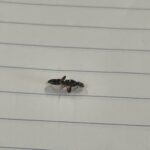Sample information |
|
| Picture |


|
|---|---|
| Location | |
| Collection date | 11/13/2024 |
| Captive / Cultivated? | Wild-caught |
| Group | Hawaii Community College |
| Observations | Easy to catch. Plump, shiny, black fly. Lucilia Sericata species suspected. |
| Putative identification | Arthropoda |
Methods |
|
| Extraction kit | pcr |
| DNA extraction location | Whole arthropod |
| Single or Duplex PCR | Single Reaction |
| Gel electrophoresis system | Edvotek Gel Electrophoresis |
| Buffer | TBE |
| DNA stain | SYBR Safe |
| Gel images |


|
| Protocol notes | Gel Lanes (Bottom of gel 1)
Gel 2 is the control PCRs. Lanes (Top with CO1, Bottom with 16S primers)
Materials and Methods DNA was extracted from two insect specimens using cell lysis and precipitation protocol. Specimens were rinsed in water to remove ethanol, blotted dry, and transferred to individual 1.5 mL microcentrifuge tubes. Each sample was macerated in 200 µL of Cell Lysis Buffer using sterile pestles, with thorough grinding to maximize DNA yield. The tubes were heated at 95°C for 5 minutes, and centrifuged to remove debris. The supernatant was transferred to tubes containing cold isopropanol, mixed, and centrifuged to pellet DNA. Pellets were washed with 70% ethanol, air-dried, and resuspended in 50 µL DNA Elution Buffer and incubated in a 65°C water bath for approximately 5 minutes. The pellet was still intact at this stage, but it was broken up by pipetting up and down a few times. It was left to incubate for an additional minute before proceeding. For PCR amplification, 2 µL of each DNA extract was added to a pre-mixed PCR master mix containing primers for arthropod CO1 and Wolbachia 16S rRNA genes. Amplification was conducted using a thermal cycler with appropriate annealing temperatures for each gene. PCR products were visualized via electrophoresis using a 2% agarose gel stained with SYBR Safe DNA dye. Gels were prepared by dissolving 0.5 g agarose in 25 mL 1× TBE buffer, cooled, and poured into a casting tray. Samples were mixed with loading dye, loaded into wells, and electrophoresed at 130 V for ~25 minutes. Bands were visualized under UV light, photographed, and analyzed. |
Results |
|
| Wolbachia presence | No |
| Confidence level | High |
| Explanation of confidence level | The controls worked and CO1 arthropod DNA extraction from flies was successful. No Wolbachia DNA detected. |
| Wolbachia 16S sequence | |
| Arthropod COI sequence |
``
BLAST at The Wolbachia Project BLAST at NCBI
|
| Summary | The Arthropoda was found to be negative for Wolbachia. |
 European Paper Wasp
European Paper Wasp Woodworm Ant
Woodworm Ant